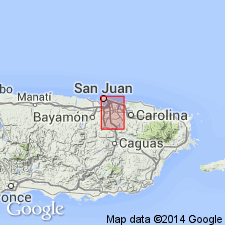
- Usage in publication:
-
- Fajardo formation*
- Modifications:
-
- Revised
- Dominant lithology:
-
- Shale
- Siltstone
- AAPG geologic province:
-
- Caribbean region
Summary:
Fajardo shales of Berkey (1915), here redefined Fajardo formation and adopted, consists of blocky, well-bedded, ashy shale or siltstone. Conformably overlies Figuera volcanics; is the upper unit of the older complex in the San Juan area. Maximum thickness is 3,000 ft. Age is late Paleocene or Eocene based on age of Figuera volcanics.
Source: GNU records (USGS DDS-6; Reston GNULEX).
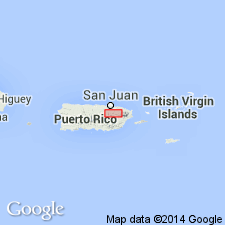
- Usage in publication:
-
- Fajardo Formation*
- Modifications:
-
- Revised
- Age modified
- AAPG geologic province:
-
- Caribbean region
Summary:
The Rio Piedras Siltstone, here renamed and adopted [Formation of Soriano and Gelabert (1964)], was previously called the Fajardo Formation by Kaye (1956), but recent discovery of Late Cretaceous ammonites in the type area of the Fajardo necessitates a new name for younger rocks near Rio Piedras.
Source: GNU records (USGS DDS-6; Reston GNULEX).
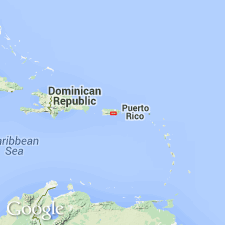
- Usage in publication:
-
- Fajardo Formation*
- Modifications:
-
- Revised
- Biostratigraphic dating
- AAPG geologic province:
-
- Caribbean region
Summary:
Aguas Buenas Limestone Member is here redefined, removed from the Fajardo Formation, and assigned to the base of the Torrecilla Breccia.
Source: GNU records (USGS DDS-6; Reston GNULEX).
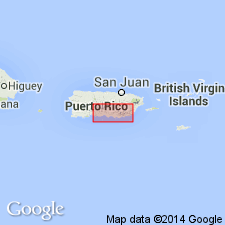
- Usage in publication:
-
- Fajardo Formation*
- Modifications:
-
- Overview
- Age modified
- AAPG geologic province:
-
- Caribbean region
Summary:
In the Coamo area of south-central PR, Fajardo Formation disconformably underlies the Robles Formation, which includes the Rio Maton Limestone, Lapa Lava, and Las Tetas Lava Members. Age of the Robles is Albian to Santonian; age of Fajardo is Early Cretaceous (Albian) based on fossils collected from the Aguas Buenas Limestone Member by Pease and Briggs (1960).
Source: GNU records (USGS DDS-6; Reston GNULEX).
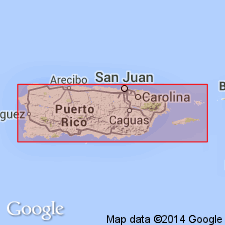
- Usage in publication:
-
- Fajardo Formation*
- Modifications:
-
- Overview
- AAPG geologic province:
-
- Caribbean region
Summary:
The Fajardo Formation occurs in eastern Puerto Rico and consists of basal tuff breccia interbedded with tuff, and tuffaceous sandstone and black cherty siltstone. Maximum estimated thickness is 3150 meters. The Fajardo is of Early Cretaceous age.
Source: GNU records (USGS DDS-6; Reston GNULEX).
For more information, please contact Nancy Stamm, Geologic Names Committee Secretary.
Asterisk (*) indicates published by U.S. Geological Survey authors.
"No current usage" (†) implies that a name has been abandoned or has fallen into disuse. Former usage and, if known, replacement name given in parentheses ( ).
Slash (/) indicates name conflicts with nomenclatural guidelines (CSN, 1933; ACSN, 1961, 1970; NACSN, 1983, 2005, 2021). May be explained within brackets ([ ]).

